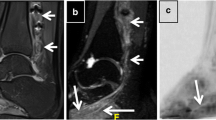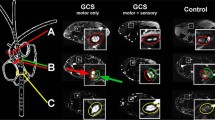Abstract
Purpose of Review
Magnetic resonance neurography (MRN) is being increasingly used as a problem-solving tool for diagnosis and management of peripheral neuropathies. This review is aimed at summarizing important technological advances, including MR pulse sequence and surface coil developments, which have facilitated MRN’s use in clinical practice.
Recent Findings
The most recent research in MRN focuses on its clinical applications, with concomitant development of three-dimensional, parallel imaging and vascular suppression techniques that facilitate higher spatial resolution and depiction of small nerve branches arising from the brachial and lumbosacral plexi as well as fascicular abnormalities of more distal extremity nerves. Quantitative diffusion tensor imaging (DTI) has been studied as a tool to detect microstructural abnormalities of peripheral nerves and more precisely define grades of nerve injury but will require additional investigation to determine its role in daily clinical practice.
Summary
MRN continues to evolve due to technological improvements and awareness by the medical community of its capabilities. Additional technological developments related to surface coil designs and vascular suppression techniques will be needed to move the field forward.





Similar content being viewed by others
References
Papers of particular interest, published recently, have been highlighted as: • Of importance
Howe FA, Filler AG, Bell BA, Griffiths JR. Magnetic resonance neurography. Magn Reson Med. 1992;28:328–38.
Heinen C, Dömer P, Schmidt T, Kewitz B, Janssen-Biehnhold U, Kretschmer T. Fascicular ratio pilot study: high-resolution neurosonography-a possible tool for quantitative assessment of traumatic peripheral nerve lesions before and after nerve surgery. Neurosurgery. 2018;85:415–422.
McGee KP, Stormont RS, Lindsay SA, Taracila V, Savitskij D, Robb F, et al. Characterization and evaluation of a flexible MRI receive coil array for radiation therapy MR treatment planning using highly decoupled RF circuits. Phys Med Biol. 2018;63:08NT02.
Bordalo-Rodrigues M. Magnetic resonance neurography in musculoskeletal disorders. Magn Reson Imaging Clin N Am. 2018;26:615–30.
• Sneag DB, Rancy SK, Wolfe SW, Lee SC, Kalia V, Lee SK, et al. Brachial plexitis or neuritis? MRI features of lesion distribution in parsonage-turner syndrome. Muscle Nerve. 2018;58:359–66 This study demonstrates that the prevailing imaging findings in Parsonage-Turner syndrome are intrinsic constrictions of peripheral nerves distal to the brachial plexus proper.
Chhabra A, Rozen S, Scott K. Three-dimensional MR neurography of the lumbosacral plexus. Semin Musculoskelet Radiol. 2015;19:149–59.
Chhabra A, Thawait GK, Soldatos T, Thakkar RS, Del Grande F, Chalian M, et al. High-resolution 3T MR neurography of the brachial plexus and its branches, with emphasis on 3D imaging. AJNR Am J Neuroradiol. 2013;34:486–97.
Fritz J, Ahlawat S. High-resolution three-dimensional and cinematic rendering MR neurography. Radiology. 2018;288:25.
Sneag DB, Mendapara P, Zhu JC, Lee SC, Lin B, Curlin J, et al. Prospective respiratory triggering improves high resolution brachial plexus magnetic resonance image quality. J Magn Reson Imaging. 2019;49:1723–9.
Yoneyama M, Takahara T, Kwee TC, Nakamura M, Tabuchi T. Rapid high resolution MR neurography with a diffusion-weighted pre-pulse. Magn Reson Med Sci. 2013;12:111–9.
• Cervantes B, Kirschke JS, Klupp E, Kooijman H, Börnert P, Haase A, et al. Orthogonally combined motion- and diffusion-sensitized driven equilibrium (OC-MDSDE) preparation for vessel signal suppression in 3D turbo spin echo imaging of peripheral nerves in the extremities. Magn Reson Med. 2017;79:407–15 This article describes a non-contrast technique for vascular suppression in MRN.
Chhabra A, Subhawong TK, Bizzell C, Flammang A, Soldatos T. 3T MR neurography using three-dimensional diffusion-weighted PSIF: technical issues and advantages. Skelet Radiol. 2011;40:1355–60.
Chen WC, Tsai YH, Weng HH, Wang SC, Liu HL, Peng SL, et al. Value of enhancement technique in 3D-T2-STIR images of the brachial plexus. J Comput Assist Tomogr. 2014;38:335–9.
Wang L, Niu Y, Kong X, Yu Q, Kong X, Lv Y, et al. The application of paramagnetic contrast-based T2 effect to 3D heavily T2W high-resolution MR imaging of the brachial plexus and its branches. Eur J Radiol. 2016;85:578–84.
Sneag DB, Curlin J, Shin J, Fung M, Lin B, Daniels SP. High-resolution brachial plexus imaging using 3-D short tau inversion recovery (CUBESTIR) with IV gadolinium for vascular suppression. International Society for Magnetic Resonance in Medicine Annual Meeting. May 14, 2019.
Noguerol M, Barousse R, Socolovsky M, Luna A. Quantitative magnetic resonance (MR) neurography for evaluation of peripheral nerves and plexus injuries. Quant Imaging Med Surg. 2017;7:398–421.
Cage TA, Yuh EL, Hou SW, Birk H, Simon NG, Noss R, et al. Visualization of nerve fibers and their relationship to peripheral nerve tumors by diffusion tensor imaging. Neurosurg Focus. 2015;39:E16.
Shah P, Argentieri E, Koff MF, Sneag DB. Quantitative evaluation of T2 signal intensity for the assessment of muscle denervation. ISMRM 25th Scientific Meeting & Exhibition. Honolulu, HI. April 22–27, 2017.
Burakiewicz J, Sinclair CDJ, Fischer D, Walter GA, Kan HE, Hollingsworth KG. Quantifying fat replacement of muscle by quantitative MRI in muscular dystrophy. J Neurol. 2017;264(10):2053–67.
Heskamp L, van Nimwegen M, Ploegmakers MJ, Bassez G, Deux JF, Cumming SA, et al. Lower extremity muscle pathology in myotonic dystrophy type 1 assessed by quantitative MRI. Neurology. 2019;92:e2803–14.
Yin L, Xie ZY, Xu HY, Zheng SS, Wang ZX, Xiao JX, et al. T2 mapping and fat quantification of thigh muscles in children with Duchenne muscular dystrophy. Curr Med Sci. 2019;39:138–45.
Chhabra A, Belzberg AJ, Rosson GD, Thawait GK, Chalian M, Farahani SJ, et al. Impact of high resolution 3 tesla MR neurography (MRN) on diagnostic thinking and therapeutic patient management. Eur Radiol. 2016;26:1235–44.
Fisher S, Wadhwa V, Manthuruthil C, Cheng J, Chhabra A. Clinical impact of magnetic resonance neurography in patients with brachial plexus neuropathies. Br J Radiol. 2016;89:20160503.
• Yoon D, Biswal S, Rutt B, Lutz A, Hargreaves B. Feasibility of 7T MRI for imaging fascicular structures of peripheral nerves. Muscle Nerve. 2018;57:494–8 This article describes the role of 7T for evaluating fascicular architecture of peripheral nerves.
Shin J, Curlin J, Tan ET, Fung M, Sneag DB. Denoising of diffusion MRI improves peripheral nerve conspicuity and reproducibility. International Society for Magnetic Resonance in Medicine Annual Meeting. Montreal, Canada. May 13, 2019.
Balsiger F, Steindel C, Arn M, Wagner B, Grunder L, El-Koussy M, et al. Segmentation of peripheral nerves from magnetic resonance neurography: a fully-automatic, deep learning-based approach. Front Neurol. 2018;9:777.
Acknowledgments
The authors would like to thank Drs. Fraser Robb and Yun-Jeong Stickle from GE Healthcare, Inc., in Aurora, OH, for designing and building the 64-channel prototype brachial plexus coil mentioned in this article.
Author information
Authors and Affiliations
Corresponding author
Ethics declarations
Conflict of Interest
Darryl B. Sneag and Sophie Queler report the Hospital for Special Surgery has an institutional research agreement with GE Healthcare.
Human and Animal Rights and Informed Consent
This article does not contain any studies with human or animal subjects performed by any of the authors.
Additional information
Publisher’s Note
Springer Nature remains neutral with regard to jurisdictional claims in published maps and institutional affiliations.
This article is part of the Topical Collection on Nerve and Muscle
Rights and permissions
About this article
Cite this article
Sneag, D.B., Queler, S. Technological Advancements in Magnetic Resonance Neurography. Curr Neurol Neurosci Rep 19, 75 (2019). https://doi.org/10.1007/s11910-019-0996-x
Published:
DOI: https://doi.org/10.1007/s11910-019-0996-x




